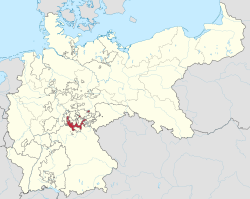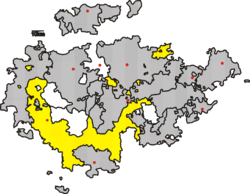
Back دوقية ساكسونيا مايننغن Arabic Саксония-Майнинген Bulgarian Sachsen-Meiningen Breton Sasko-meiningenské vévodství Czech Hertugdømmet Sachsen-Meiningen Danish Herzogtum Sachsen-Meiningen German Σαξονία-Μάινινγκεν Greek Saksio-Meiningen Esperanto Ducado de Sajonia-Meiningen Spanish Saksi-Meiningeni hertsogiriik Estonian
This article needs additional citations for verification. (May 2007) |
Duchy of Saxe-Meiningen (1680–1918) Herzogtum Sachsen-Meiningen Free State of Saxe-Meiningen (1918–1920) Freistaat Sachsen-Meiningen | |||||||||
|---|---|---|---|---|---|---|---|---|---|
| 1680–1920 | |||||||||
| Anthem: Vaterlandsgesang der Sachsen-Meininger | |||||||||
 Saxe-Meiningen within the German Empire | |||||||||
 Territories of Saxe-Meiningen within the Ernestine duchies after 1826 | |||||||||
| Status | State of the Holy Roman Empire, State of the Confederation of the Rhine, State of the German Confederation, State of the North German Confederation, Constituent state of the German Empire | ||||||||
| Capital | Meiningen | ||||||||
| Government | Duchy (1680–1918) Republic (1918–1920) | ||||||||
| Duke | |||||||||
• 1675–1706 | Bernhard I (first) | ||||||||
• 1914–1918 | Bernhard III (last) | ||||||||
| Historical era | Early modern period | ||||||||
• Partitioned from Saxe-Gotha | 1680 | ||||||||
• Acquired Saxe-Hildburghausen | 1826 | ||||||||
| 1918 | |||||||||
• Merged into Thuringia | 1920 | ||||||||
| |||||||||
Saxe-Meiningen (/ˌsæks ˈmaɪnɪŋən/ SAKS MY-ning-ən; German: Sachsen-Meiningen [ˌzaksn̩ ˈmaɪnɪŋən]) was one of the Saxon duchies held by the Ernestine line of the House of Wettin, located in the southwest of the present-day German state of Thuringia.
Established in 1681,[1] by partition of the Ernestine Duchy of Saxe-Gotha among the seven sons of deceased Duke Ernest the Pious, the Saxe-Meiningen line of the House of Wettin lasted until the end of the German monarchies in 1918.[2]
- ^ Herbermann, Charles, ed. (1913). . Catholic Encyclopedia. New York: Robert Appleton Company.
- ^ "Die herzogliche Familie (German)". Meininger Museen. Archived from the original on 18 August 2017. Retrieved 10 May 2019.

